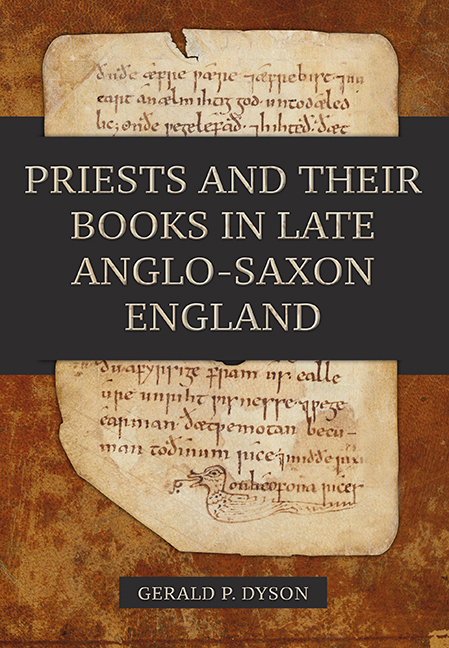Book contents
- Frontmatter
- Dedication
- Contents
- List of Illustrations
- Acknowledgements
- Introduction
- 1 Priests, Books, and Pastoral Care
- 2 “Ne cunnon þæt leden understandan”: Issues of Clerical Literacy
- 3 Demand and Supply: Production and Provision of Books for Priests
- 4 Preaching and Homiletic Books for Priests
- 5 Performing the Liturgy: Priests’ Books for the Mass and Office
- 6 Locating Penitentials, Manuals, and Computi
- Conclusions
- Appendix
- Bibliography
- Index
- Anglo-Saxon Studies
- Frontmatter
- Dedication
- Contents
- List of Illustrations
- Acknowledgements
- Introduction
- 1 Priests, Books, and Pastoral Care
- 2 “Ne cunnon þæt leden understandan”: Issues of Clerical Literacy
- 3 Demand and Supply: Production and Provision of Books for Priests
- 4 Preaching and Homiletic Books for Priests
- 5 Performing the Liturgy: Priests’ Books for the Mass and Office
- 6 Locating Penitentials, Manuals, and Computi
- Conclusions
- Appendix
- Bibliography
- Index
- Anglo-Saxon Studies
Summary
A recent collection of essays has characterized early medieval priests as “men in the middle”, and the characterization is apt. Priests, particularly local priests, were interposed between the higher clergy and the laity, secular authority and local communities, and most importantly, between God and humanity. Priests’ roles as spiritual mediators were integrally connected with the rites and ministries of pastoral care, and priests brought literacy and liturgical experience to this aspect of their vocation. This book has focused on one of the few ways to access this essential feature of priestly life: the books used by priests. Many of these books were humble, practical volumes for everyday use. Constant use and changing liturgical trends, combined with a lack of institutional stability in many minor churches, has led to poor rates of survival for priests’ books, especially those from Anglo-Saxon England. In spite of this, the analysis of documentary and manuscript evidence for late Anglo-Saxon priests’ books sheds new light on the early medieval clergy and the practice of pastoral care.
Fundamentally, the evidence analyzed in this book indicates that Anglo-Saxon priests were expected to have access to a core of priestly texts that would enable them to provide pastoral care as well as the ability to use these books in the performance of their duties. As demonstrated in the Introduction and chapter 1, early medieval bishops in England and on the continent saw access to books as essential to pastoral care and the education of the clergy. As a result, bishops frequently provided lists of the books that priests needed to own. These have in some ways acted as a guide for this study and they certainly point to the importance of considering priests’ books as an integral part of understanding pastoral care. While some contemporary sources expressed doubts about priestly literacy in Latin, it is significant that they do not make similar pronouncements about a lack of essential books. Furthermore, the liturgical competence of secular priests was not commonly maligned, but rather assumed in high expectations of their liturgical capability. Various sources, such as accounts of priestly performance of the liturgy, scribal activity, and accounts of clerical training, testify to, at minimum, the possession of functional literacy on the part of Anglo-Saxon priests in performing their pastoral duties. Certainly the greatest difficulty of studying Anglo-Saxon priests’ books is the limited nature of the manuscript evidence.
- Type
- Chapter
- Information
- Priests and their Books in Late Anglo-Saxon England , pp. 227 - 234Publisher: Boydell & BrewerPrint publication year: 2019

